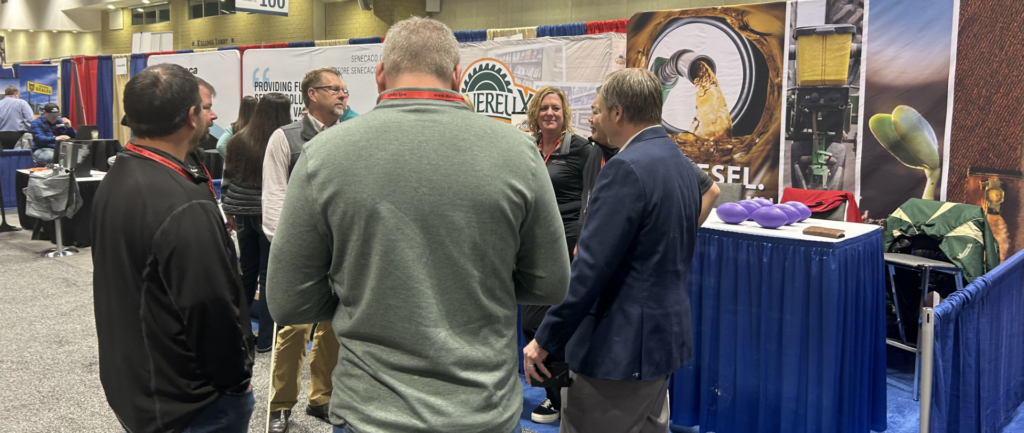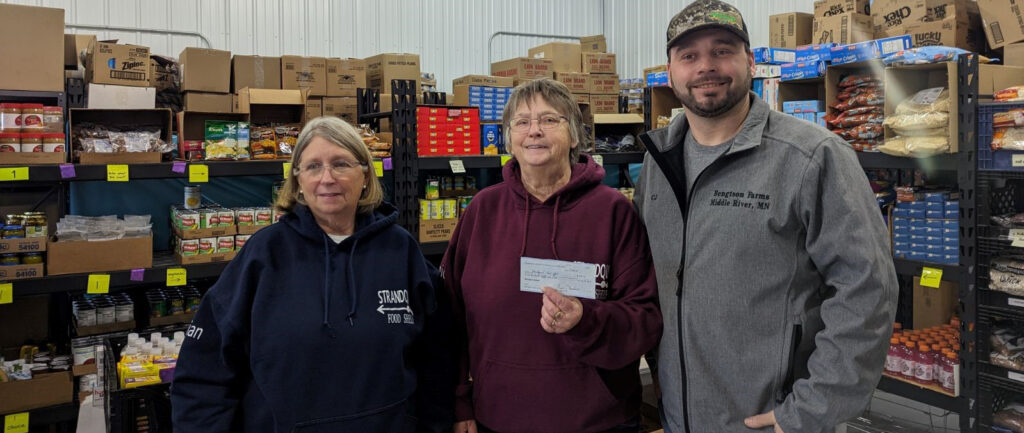March 15, 2018 honoring 16 years of Minnesota requiring 2 percent blend of biodiesel
Normally I’m not one to reminisce. You can put me in the category of those folks who try to learn from the past and keep moving forward. But sometimes I catch myself looking in the rearview mirror at a certain period in life, and despite realizing that time moves lightning fast as I age, I find that progress and success can be more accurately measured with the benefit of hindsight.
Sixteen years ago, March of 2002, a gallon of unleaded gas averaged around $1.36 a gallon. Barry Manilow, Cher and Britney Spears could all claim to have hit albums on the charts. Ice Age was dominating the box office. King of Queens and Everybody Loves Raymond were among the television shows doing well in the ratings.

A simpler time? Well, in mid-March, many Minnesota residents awoke to double-digit snow totals after a storm arrived the previous evening. Despite the storm, it was business as usual for then-Gov. Jesse Ventura, holding a news conference on his stadium proposal for the Twins. And in what may not be characterized as the stuff of headlines, but also that same month, Minnesota became the first in the nation to require that all diesel fuel sold in the state contain at least a 2 percent blend (B2) of biodiesel.
It may not have been the lead topic on the evening news, but those of us who’ve spent our lives in rural communities and worked in agriculture saw promise. Hard work remained, as it would be another three years before implementation, but the ensuing decade has seen great progress.
Cal Ripken of Biofuels
It’s rare in the age of message bombardment that a successful advanced biofuel such as biodiesel can be summed up in a few, rather ordinary words. Sustainable. Growth. Environment. Jobs. Potential.
But, as often is the case, “steady” in today’s world may not necessarily raise eyebrows. We live in a society that yearns for the quick fix and immediate returns. What better way to explain such claims as “30 Days to a New Body” or “Earn an Extra $10,000 a Month in Your Spare Time.”
Success and growth is often methodical, not necessarily eye-catching. And opportunity, in the words of Thomas Edison, “is missed by most people because it is dressed in overalls and looks like work.” But when opportunity knocks … well, you know where I’m going.
The biodiesel movement in Minnesota was never going to be an overnight sensation, nor a flash in the pan for that matter. The passage of the B2 legislation was a painstaking process.
“Biodiesel wasn’t unknown and in fact at that time, there were a lot of rural legislators that knew about it,” recalls Mike Youngerberg of the Minnesota Soybean Research and Promotion Council. “There was definitely some pushback from the petroleum and trucking industries. It was quite a bipartisan effort in the end, but it took time.”
Jim Willers of Beaver Creek, Minnesota, was another farmer who made many a trip to the state capitol in the early 2000s to push for the B2 mandate. A sense of dedication to his profession drove him during those long days and nights.
“This is using your own product, whether it be ethanol or biodiesel,” Willers says. “If you raised the crop that produced the fuel, you use the crop that you’re raising.”
Those spearheading the effort to put biodiesel on the map in Minnesota were forward thinkers, according to Scott Hedderich of Renewable Energy Group Inc.
“These guys were truly visionaries,” Hedderich says. “Not only to be a visionary, but to lay out a piece of legislation as thoughtful that they did, with important milestones, and off ramps if things didn’t work out, really is a testament to the activism and brain power that they had. It’s really impressive.”
A Small Step Forward, Giant Leap on the Horizon
At the Minnesota Farmfest Show in Redwood County, Minnesota, in 2007, then-Gov. Tim Pawlenty laid down the gauntlet with a 20 percent renewable fuels proposal. Needless to say, it raised eyebrows in the state capitol as well as among the farmers in attendance, including Youngerberg.
“I think his desire was to be a green governor,” Youngerberg says. “That drove him. The governor came along with this 20 percent liquid renewable fuels thing and in a lot of ways surprised the soybean and biodiesel folks. Now we’re going to lay out a path to B20? There was a lot of discussion with the governor’s office and that’s where we came to talk about B5, B10 and B20.”
Pawlenty established the Minnesota Biodiesel Task Force in 2003 to begin implementation of the B2 mandate, and later charged it with promotion and education regarding the proposed B20 mandate.
More legislative battles ensued over the years but the writing on the wall was clear: Minnesota was moving to the forefront of the renewable fuels movement. In 2014, Minnesota became the first state in the nation to require 10 percent biodiesel, or B10, in diesel blends sold during the summer months. B10 is required from April 1 to Sept. 30 and B5 is required during the remaining winter months. And on May 1 of this year, the summer blend will increase to B20.
Economic and Environmental Report Card
In just 16 years, Minnesota’s biodiesel industry, which had to grow to meet the requirements of the B2 mandate, transformed itself into a 74 MMgy industry.
According to the Minnesota Department of Agriculture, the state consumes 1 billion gallons of diesel fuel a year, of which 77 million gallons come from biodiesel. Minnesota currently supplies 74 million gallons, or 96 percent, of its own biodiesel needs, and imports 3 million gallons, or 4 percent, from other states to fulfill the consumption demand. On May 1, when the B20 mandate goes into effect, Minnesota’s annual biodiesel demand will reach 130 million gallons.
In 2017, MDA released the results of a study on the economic impact of biodiesel in Minnesota. Based on the 2016 biodiesel production of 74 million gallons, the report found that every million gallons of biodiesel production contributes $22.8 million in statewide total economic output. The total economic output impact is estimated to be $1.7 billion, with the total employment impact estimated at 5,397 jobs.
“When we can grow it, raise it and refine it here, it’s a great economic engine for the state of Minnesota,” says Theresia Gillie, a director for the Minnesota Soybean Growers Association.
On the environmental front, the state has seen the positive impacts of a cleaner-burning fuel. According to the American Lung Association of Minnesota’s analysis of biodiesel as a fuel standard for Minnesota (2005-2015), a reduction of more than 7.4 billion pounds of carbon dioxide, which is equivalent to more than 3.7 million tons of carbon dioxide, has already been realized. Over that 10-year period, ALAMN estimates it is comparable to removing the emissions from 706,649 passenger vehicles or 17,998 railcars of coal.
With those types of numbers, biodiesel has surprisingly found itself as not a darling of the environmental movement in the state.
“They saw diesel as dirty for so long,” Youngerberg says. “I think they just wrote it off, and you couldn’t do anything about it. These days, with the current state of technology of diesel engines, we’ve got diesel running as clean, if not cleaner, than gasoline.”
The Move to B20 in 2018
According to MDA, the state’s current production capacity can provide about 91 percent of the B10 need and about 55 percent of biodiesel needed to meet the B20 mandate in 2018. A state law requires the transition to B20 depends on the state making a number of factual findings about its readiness to move forward.
In MDA’s annual report on biodiesel to the legislature, it found that “given the large soybean oil crushing capacity in Minnesota, much of the soy oil used in Minnesota biodiesel plants is likely to be sourced from Minnesota oil producers.”
One of the conditions of the Minnesota biodiesel mandate is that “a sufficient supply of biodiesel is available and the amount of biodiesel produced in this state from feedstock with at least 75 percent that is produced in the United States and Canada is equal to at least 50 percent of anticipated demand at the next minimum content level.”
There are rumblings that biodiesel opponents will look at these numbers as the next line in the sand against the industry. The trucking and oil companies will continue to develop new arguments and stalling tactics as the move to B20 approaches.
“They’re hoping to get a delay and get Gov. Mark Dayton out of office and pray for a new governor to get rid of all of this,” Youngerberg says.
A Sense of Pride
Those of us who’ve spent a lifetime in agriculture don’t need reminders how our fortunes, and I use the term loosely, can change quickly from one growing season to the next. Hollywood often depicts farmers as constantly facing a tsunami of bad news from Mother Nature, lenders and children that want to flee to greener pastures as they enter adulthood. Case in point: If you’re not in the right frame of mind, try to avoid 1984’s The River with Mel Gibson and Sissy Spacek as a farming couple in Tennessee. Trial, tribulation and heartache.
While we’re definitely not strangers to adversity, our relationship with our land and our crops revolves around a sense of pride. Biodiesel has added to that equation. Another product that offers promise of a better future. And it helps with the bottom line, adding value to every bushel of soybeans.
The biodiesel movement in Minnesota has grown leaps and bounds in 15 years, an infancy for an industry.
“I grow soybeans and at one time, I was a process operator at a biodiesel plant,” says Chris Hill of Brewster, Minnesota. “So I grow it. I’ve processed it. And I’ve used the end product on my farm. So it really has come full circle for me.”
There’s no doubt we’ll continue to face challenges along the way. But our commitment has never wavered. I’m reminded of the words of former Speaker of the U.S. House of Representatives, Newt Gingrich: “Perseverance is the hard work you do after you get tired of doing the hard work you already did.”
The journey has been long. We’re rolling up our sleeve and we’re eyeing up the finish line. We vow to finish strong.
Author: Tom Slunecka, Minnesota Soybean CEO







